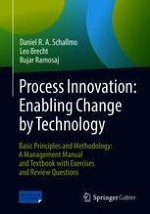2018 | Buch
Process Innovation: Enabling Change by Technology
Basic Principles and Methodology: A Management Manual and Textbook with Exercises and Review Questions
verfasst von: Prof. Dr. Daniel R. A. Schallmo, Prof. Dr. Leo Brecht, Bujar Ramosaj
Verlag: Springer Berlin Heidelberg
